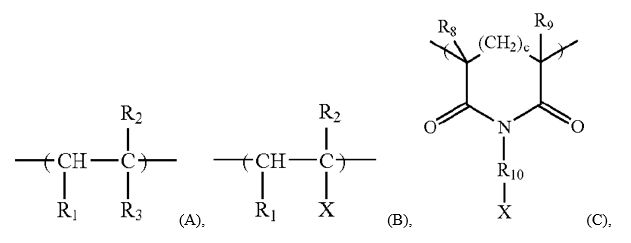In the matter of Ex parte HAN LIU, et al., the Patent Trial and Appeal Board (PTAB) determined on August 17, 2023, that an examiner (Sarah al-Awadi, supported by Supervisory Patent Examiners, David J. Blanchard and Sue X. Liu) failed to establish the prima facie obviousness of claims by failing to establish a clear motivation and a reasonable expectation of success in maintaining the function of a copolymer-Ag system, inter alia, in modifying a particular monomer content to overlap with the claims against the disclosure of the primary references. The independent claims in question recited (emphasis added):
[a]n antimicrobial coating composition comprising
(i) a polymer emulsion and
(ii) from 20ppm to 6000ppm, by dry weight based on total dry weight of the coating composition, a silver,
wherein the polymer emulsion comprises a copolymer having, as polymerized units,
(a) ethylenically unsaturated nonionic monomers, and
(b) from 0.01% to 2%, by dry weight based on total dry weight of the polymer emulsion, heterocyclic group-containing monomers and
wherein the mole ratio of heterocyclic groups in the heterocyclic group-containing monomers to silver is at least 4,
(iii) one or more pigment, one or more extender, or both one or more pigment and one or more extender, at a pigment volume concentration of 10 to 75%, and
optionally, a surfactant,
wherein, excluding the optional surfactant, there is only one polymer in the composition.
[a]n antimicrobial coating composition comprising
(i) a polymer emulsion and
(ii) from 20ppm to 6000ppm, by dry weight based on total dry weight of the coating composition, a silver,
wherein the polymer emulsion comprises a copolymer having, as polymerized units,
(a) ethylenically unsaturated nonionic monomers, and
(b) from 0.01% to 2%, by dry weight based on total dry weight of the polymer emulsion, heterocyclic group-containing monomers and
wherein the mole ratio of heterocyclic groups in the heterocyclic group-containing monomers to silver is at least 4
wherein the heterocyclic group-containing monomers comprise vinyl imidazole.
[a]n antimicrobial coating composition comprising
(i) a polymer emulsion of a copolymer and
(ii) from 20ppm to 6000ppm, by dry weight based on total dry weight of the coating composition, a silver,
wherein the copolymer comprises, as polymerized units,
(a) ethylenically unsaturated nonionic monomers, and
(b) from 0.01% to 2%, by dry weight based on total dry weight of the polymer emulsion, heterocyclic group-containing monomers and
wherein the mole ratio of heterocyclic groups in the heterocyclic group-containing monomers to silver is at least 4, and
(iii) one or more pigment, one or more extender, or both one or more pigment and one or more extender in amount of 10 to 75% pigment volume concentration, and optionally
(iv) oxidant in amounts of 0.004 to 10% by dry weight of the coating composition,
wherein the amount of the polymer emulsion of the copolymer makes up the remainder of the dry weight of the coating composition.
[a]n antimicrobial coating composition comprising
(i) a polymer emulsion and
(ii) from 20ppm to 6000ppm, by dry weight based on total dry weight of the coating composition, a silver,
wherein the polymer emulsion comprises a copolymer including, as polymerized units,
(a) ethylenically unsaturated nonionic monomers, and
(b) from 0.01% to 2%, by dry weight based on total dry weight of the polymer emulsion, heterocyclic group-containing monomers and
wherein the mole ratio of heterocyclic groups in the heterocyclic group-containing monomers to silver is at least 4,
wherein the polymer of the polymer emulsion further comprises, as polymerized units, by dry weight based on total dry weight of the polymer emulsion,
(c) from 0.01% to 5%, stabilizer monomers.
The successful appeal for the above claims reversed rejections over the appellant's own prior art (1) US 2011/0243882 A1 (Dong, a co-inventor of the appealed case with an additional common co-inventor, Zhang, along with other non-overlapping co-inventors), and optionally further US 2004/0151910 A1 (Koller, claim 5, another reference belonging to the appellant) and over (2) US 7,390,774 (Ghosh) and Dong, and optionally Koller (claim 5). Three obviousness-type double patenting rejections involving Dong, Ghosh, and a third appellant reference, were correspondingly reversed.
The initial independent claim filed March 12, 2018, recited
[a]n antimicrobial coating composition comprising (i) a polymer emulsion and (ii) from 20ppm to 6000ppm, by dry weight based on total dry weight of the coating composition, a silver, wherein the polymer emulsion comprises, as polymerized units, (a) ethylenically unsaturated nonionic monomers, and (b) from 0.01 % to 20%, by dry weight based on total dry weight of the polymer emulsion, heterocyclic group-containing monomers.
This claim was rejected by (junior) Examiner al-Awadi, signed by SPE Blanchard (who also sent the case to appeal), over Dong. The subsequent roughly 10 responses to rejections based on Dong (and Ghosh after the 3rd office action) sequentially amended independent claim 1 to recite that a "mole ratio of heterocyclic groups in the heterocyclic group-containing monomers to silver is at least 4" (1st response); that "(c) one or more of pigment and extender, at a pigment volume concentration of 10 to 75%, wherein there is only one polymer in the composition" (3rd response); for element (c) "one or more extender, or both one or more pigment and one or more [extender]" (4th response); and that a "... the polymer emulsion comprises a copolymer having, as polymerized units, (a) ..." and "... optionally, a surfactant, wherein, excluding the surfactant, there is only one ..." (5th response). The further independent claims were added stepwise in prosecution.
From start to finish, the examiner's rejections relied upon Dong's claims, particularly Dong's claims 1, 2, and 4, which recited (emphasis added):
1. An aqueous antibacterial polymer emulsion comprising, based on the dry weight of the emulsion, from 90 to 99.9 wt % a polymer A, from 0.004 to 1 wt % an oxidant and from 0.002 to 1 wt % a metal complexed with a copolymer B that comprises from 5 to 95 wt % a heterocyclic containing monomer residue; wherein the metal is selected from copper, silver, gold, tin, zinc and combinations thereof; and wherein the emulsion is heat stable.
2. The antibacterial polymer emulsion of claim 1, wherein the heterocyclic containing monomer residue is 1-vinylimidazole.
4. The antibacterial polymer emulsion of claim 1, wherein the metal is silver.
The examiner acknowledged that Dong disclosed at least 5 wt.% of the heterocyclic containing monomer residue, rather than "from 0.01% to 2%, by dry weight based on total dry weight of the polymer emulsion, heterocyclic group-containing monomers," as claimed. However, certain incongruities between the language of the claims and Dong's disclosure were apparently grounds for the examiner alleging that there could have been an overlap between Dong's disclosure and the claims. Dong's ¶ [0015] describes that:
[t]he copolymer B comprises, as copolymerized units, by weight percentage based on the dry weight of the copolymer B, from 5 to 95%, preferably from 10 to 90%, more preferably from 20 to 80%, a heterocyclic containing monomer. In one embodiment, the copolymer B comprises monomer residues selected from residue A, residue B, residue C and mixtures thereof, with the proviso that the polymer contains no more than 99.5 wt % of monomer residues of residue B, alternatively no more than 99 wt % of monomer residues of residue B, alternatively no more than 98 wt % monomer residues of residue B, alternatively no more than 95 wt % of monomer residues of residue B, alternatively no more than 90 wt % of monomer residues of residue B;
That is, Dong described not only a lower limit of 5 wt.% heterocyclic containing monomer, but also a preference for 10 or 20 wt.% of the heterocyclic containing monomer. Notwithstanding, the examiner went through long-winded contortions to construe the claims to overlap with Dong. Moreover, Dong's ¶ [0007] described that Dong's first polymer A makes up at least 90 weight% (preferably at least 95 or at least 99%) of the polymer emulsion and serves as a binder in coating compositions, violating the feature in claim 1 that "excluding the optional surfactant, there is only one polymer in the composition" and/or "by dry weight based on total dry weight of the polymer emulsion."

wherein X is a heterocycle.
The examiner likewise set forth complicated constructions of Ghosh's disclosure to construe Ghosh, too, to have the heterocyclic component claimed, although the appellant argued that the embodiment described in Ghosh corresponded to that described in the heterocyclic monomer content description at col. 5, ll. 13 to 201.
The PTAB found that the examiner had not persuasively shown that a polymer emulsion meeting appealed claim 1would have been obvious based on Dong. The PTAB reversed all rejections based on the failure of the examiner to show that either Dong or Ghosh described or made obvious a polymer emulsion comprising a copolymer having, as polymerized units, "(a) ethylenically unsaturated nonionic monomers, and (b) from 0.01% to 2%, by dry weight based on total dry weight of the polymer emulsion, heterocyclic group-containing monomers."
This case is a reminder that, particularly if an applicant is in a non-litigious market sector, clearly describing and claiming distinctions between the prior art well known to the applicant may help to illustrate distinctions between past applications and thereby limit prosecution costs. In the case of Ex parte HAN LIU, the prior art (Dong) even shared two inventors with the successfully appealed application. Moreover, the salient claim features to the successful appeal were present upon filing. Applicants convinced of their position, as appears to have been the case in Ex parte HAN LIU, may avoid costs by more quickly taking their cases to appeal. It is often the case at the USPTO that junior examiners are more likely to reject claims than senior examiners, although it is generally true that it is safer to reject a case than to allow a case at the USPTO. The USPTO examining corps, as illustrated by the signatory examiner and other SPE in this case, each of whom were conferees before the appeal, takes a permissive approach towards obviousness in many instances which does not always conform with the governing case law from the Federal Circuit. Without appealing, there is no opportunity to gain a hearing from a USPTO body authorized to more directly consider the Federal Circuit decisions outside of the MPEP and examination guidelines and training set up for examiners.
Finally, it appears that the PTAB is somewhat consistently treating non-overlapping ranges of the prior art with preferred sub-ranges to more remote (less close) ranges to fail to render claims obvious. In this and other recent PTAB decisions (see, for example, my previous post here), the "teaching" of the prior art of non-overlapping range and a preference for yet further distant endpoints is often treated as sufficient to make claims allowable.
Footnote
1. The portion in question described, "[i]n another embodiment of the present invention, the antimicrobial composition comprises a heterocyclic containing monomer and a non-heterocyclic containing monomer. In one aspect of this embodiment, the ratio of the heterocyclic containing monomer to the non-heterocyclic containing monomer is 95:5 to 5:95; alternatively 80:20to 20:80; alternatively 60:40 to 40:60. In one aspect of this embodiment, the heterocyclic containing monomer is vinylimidazole."
The content of this article is intended to provide a general guide to the subject matter. Specialist advice should be sought about your specific circumstances.

